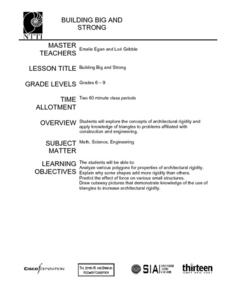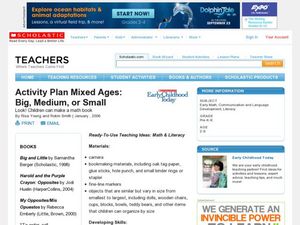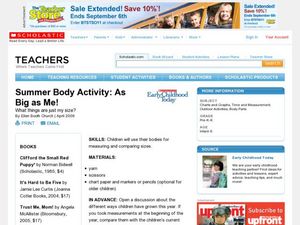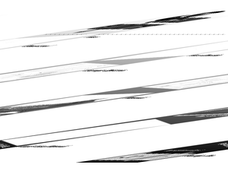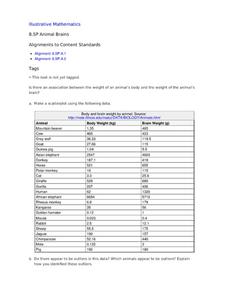Curated OER
Small
In this visual discrimination worksheet, students analyze the two pictures of animals. Students circle the picture in each row that is the smallest. There are 5 questions.
Positively Autism
"The Napping House" Big and Little
The dog is big. The mouse is little. Using vocabulary words introduced in the previous lesson, kids read, or are read, sentences and examine images that contrast big and little.
National Nanotechnology Infrastructure Network
Big vs. Little - Macro to Micro Lesson 2
The big world is full of tiny surprises. Classes discover all things big and small while completing the second lesson plan of a five-part series comparing macro- and micro-objects. Learners collect items from around the room including...
Curated OER
Big and Small
Sorting big and small objects builds spacial reasoning classification, and visual discrimination skills. Your class will read a story about big and small bubbles, practice identifying big and small objects, then sort big and small balls...
Curated OER
Building Big and Strong
Middle and high schoolers explore the concepts of architectural rigidity. They analyze a variety of polygons, and explain why some shapes add more strength to structures than others. The PBS video, "Building Big," is utilized in this plan.
Curated OER
Comparisons - Large and Small Objects
In this comparison worksheet, 1st graders visually distinguish a big object from a small one. They fill in the boxes under each of 4 objects with the either the word big or small as they compare pictures of zebras, and trees.
Curated OER
Big and Small
Sudents look at and study 4 frames with big and small objects in each one. Students follow the directions at the bottom of each frame and color what is requested to be colored in each picture. A good, basic worksheet for young learners.
Curated OER
Sorting and Classifying Concrete Objects by Varying Attributes
First graders examine how to sort concrete objects by their attributes. In this sorting instructional activity, 1st graders listen to Gray Rabbit's Odd One Out by Alan Baker, and discuss the actions of the main character. They practice...
Adrian College
The Universe
Young scientists create a simulation of Hubble's law. Introducing the Big Bang Theory using balloons and a simple lab worksheet, scholars complete a data table and perform analysis.
Curated OER
"A Pig is Big"
Students explore the concept of big, bigger, and biggest. They examine and classify items by size, listen to and discuss the book "A Pig is Big," complete a fill in the blank activity, and create a tri-fold that illustrates two items...
Center for Math and Science Education
Pocket Solar System
How in the world can something as big as the solar system possibly fit in your pocket? Complete this simple modeling activity and find out, as young scientists gain an appreciation for the incredible scale of outer space.
K5 Learning
Sun, Stars and Moon
Learners read about the objects we see in our night and day skies before answering five short answer comprehension questions.
Curated OER
How Big is a Foot?
Introducing measurement can be as simple as reading a book and then using measurement tools to understand how big a foot really is. The class reads and discusses the book How Big is a Foot? by Rolf Myller, stopping often to consider the...
Curated OER
Identify and Circle the Objects – Big or Small
In this big and small learning exercise, students circle objects that are either big or small for whichever question is asked. Students complete 20 problems total.
Curated OER
Activity Plan Mixed Ages: Big, Medium, or Small
Students make a math book. In this early childhood math lesson plan, students develop language, observation, and math skills as they explore the sizes of objects and use cameras to take pictures for their own math booklet based on...
Curated OER
Summer Body Activity: As Big as Me!
Students explore things that are their size, literally. For this early childhood lesson plan, students use their bodies for measuring and comparing sizes as they work in pairs to complete the activity.
Curated OER
Big Enough?
Students explore the concept of density and buoyancy. In this physics lesson, students discover the different factors that affect an object's density and buoyancy in water. Students conduct several investigations to further understand...
Colorado State University
Why Do Raindrops Sometimes Land Gently and Sometimes with a Splat?
A mouse can fall from large heights without injury! Air resistance is a large influence on small falling objects. In an exploratory lesson, young scholars build a raindrop bottle to compare the falling rate of different-sized objects.
Curated OER
My Foot and the Standard Foot
Young mathematicians put one foot in front of the other as they learn how to measure length in an elementary math lesson. Using paper cutouts of their own feet, children measure classroom objects as they discover the importance of...
Maine Math & Science Alliance
Earth as a System
Ecosystem, human body system, weather system. We hear the word system a lot, but what does it really mean? In the activity, pairs or groups of learners discuss how a bicycle is a system and then analyze objects in their classroom and...
Curated OER
Animal Brains
Do big bodies make big brains? Let your learners decide whether there is an association between body weight and brain weight by putting the data from different animals into a scatterplot. They can remove any outliers and then make a line...
Curated OER
Nanaotechnology: Small Science, BIG DEAL!
Students read an article that introduces them to the science and applications of nanotechnology. They discuss the the everyday examples of how nanotechnology is and can be used. In small groups, they observe and make inferences about...
Curated OER
Compare-Big/Small
In this comparison worksheet, students determine which object in sets are big or small. A website reference is given for additional resources.
Curated OER
HOW SMALL AM I? THE SCIENCE OF NANOTECHNOLOGY
Learners study nanotechnology and investigate the dimensions of a nanoscale. In this nanometer study lesson plan students will see how truly small a nanometer is by measuring things such as a piece of hair.






